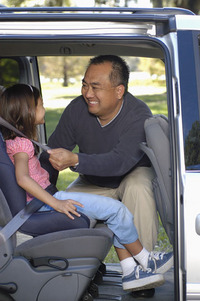Safe Kids USA Says Let's Stop Child Heat Stroke Deaths in Vehicles
 |
-- Sets target date of 2013 to eliminate deaths
-- Calls for specific education and enactment measures
WASHINGTON--July 29, 2011: Safe Kids USA today called on government, advocacy groups, automakers and car seat manufacturers to combine efforts to eliminate child heat stroke deaths in vehicles by 2013.
"We must take action now because kids are dying," said Torine Creppy, executive director of Safe Kids USA. "We can tally the statistics and explore the reasons why these tragedies occur, but we cannot calculate the grief and agony suffered by the families who have lost their precious children. A national campaign through multiple channels is needed to help ensure that parents and caregivers receive clear, consistent recommendations to prevent these needless deaths."
"This is deja vu," said Creppy. "In the 1990s children were dying due to air bag deployments. Government, advocates and industry came together and helped successfully campaigned to move children to the back seats of cars, raise seat belt use among adults and increase child safety seat use. That campaign is a great template for what we need now."
At a National Highway Traffic Safety Administration (NHTSA) roundtable with advocacy groups, automakers and car seat manufacturers this week, Safe Kids strongly encouraged the group to take a united approach to eliminate child hyperthermia.
"We should all commit to supporting a goal of eliminating child hyperthermia deaths by 2013, if not sooner," said Creppy. "Safe Kids believes it can be done with a coordinated national effort. It is time to combine our efforts and bring forth the resources to successfully stop these tragedies.
"Advanced technologies may help prevent child heat stroke deaths in vehicles, and Safe Kids urges child seat manufacturers and automakers to continue research and development of these technologies," reiterated Creppy. "However, the near-term emphasis must remain on education and awareness as it will take years for technology solutions to become widespread."
Safe Kids, through its more than 600 coalitions -- involving 10,000 professionals including nurses, doctors, policemen, firefighters and others -- has been working for several years to help prevent child hyperthermia deaths through its "Never Leave Your Child Alone" program. This year, the focus is on special task forces in eight states to heighten awareness, including Texas, where the number of child hyperthermia deaths leads the nation. But more is needed.
Safe Kids also called for expanded efforts with child care centers and pre-schools, noting that these facilities "are daily touch-points for parents and care-givers. Safe Kids believes mandatory procedures that require a confirmation when a child is dropped-off between the child care center and the parents and caregivers should be considered," Creppy said.
"Safe Kids has developed model legislation, and we hope NHTSA, automakers, car seat manufacturers and others will join us in advocating for child protection laws in the 31 states without them," added Creppy. "Right now, more states have laws about unattended dogs in vehicles than unattended kids in vehicles. This is an oversight that must be addressed."
Other suggestions include significantly greater involvement by pediatricians as part of well-baby visits and expanded education efforts by weathercasters. "We frequently hear our weathercasters make note of caring for elderly or never leaving pets in cars on hot days. But they usually do not mention children," said Creppy.
About Safe Kids USA
Safe Kids USA is part of Safe Kids Worldwide, a global network of organizations whose mission is to prevent unintentional childhood injury, the leading cause of death and disability to children ages 1 to 14. More than 600 coalitions and chapters across the U.S. and the more than 20 member countries across the globe bring together health and safety experts, educators, corporations, foundations, governments and volunteers to educate and protect families. For more information visit www.safekids.org


